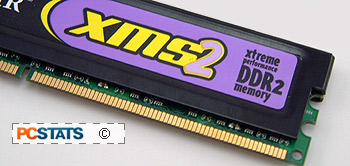 |
| Overclocking Results: |
|
|
With the Corsair Twin2X2048-6400C3 memory voltage
set at 2.2V and the timings at 3-4-3-9, the motherboard clock speed was increased in 2-4 MHz increments. At stock settings, the Corsair Twin2X2048-6400C3 did not get very far before problems started to pop up. At 214 MHz the system simply wasn't stable enough to pass 3DMark05, so an increase of memory voltage to 2.3V was needed.
With 3-4-3-9 CAS Latency timings, the memory didn't go up much further, and 218 MHz was the highest the Corsair Twin2X2048-6400C3 memory would run at in the end. Unfortunately due to a situation with the CPU clock multiplier and memory divider, odd multipliers on Socket AM2 Athlon64's cause the memory to run at lower than DDR2-800 speeds.
This is why memory bandwidth numbers with the Athlon64 X2 5000+ based
platform are considerably slower than with the FX-62. This means if I want the
memory to run at DDR2-800 speeds, I'd have to use only even multipliers. In
this case, we decided to leave the clock multiplier at its stock 14x setting.
The CPU speed will affect the benchmarks slightly, but not enough to completely
skew the results.
 Loosening up the timings to JEDEC DDR2-800 settings of 5-5-5-15 allowed the memory to clock up much higher. Continuing from where the Corsair Twin2X2048-6400C3 left off with tight timings (218MHz), the memory was pushed further in 4-6 MHz steps.
Loosening up the timings to JEDEC DDR2-800 settings of 5-5-5-15 allowed the memory to clock up much higher. Continuing from where the Corsair Twin2X2048-6400C3 left off with tight timings (218MHz), the memory was pushed further in 4-6 MHz steps.
With a voltage of 2.3V, the Corsair Twin2X2048-6400C3 memory maxed out at 264 MHz which is pretty good for DDR2-800 rated memory. We only benchmarked at the lower speed/lower latency setting however.
Prelude to Benchmarks
The details of how the Corsair Twin2X2048-6400 C3 memory test
system was configured for benchmarking, including the specific hardware,
software drivers, operating system and benchmark versions are indicated below.
In the second column are the general specs for the reference platforms this pair
of DDR-2 memory is to be compared against. Please take a moment to look over
PCSTATS test system configurations before moving on to the individual benchmark
results.
 |
| PCSTATS Test System Configurations |
|
|
 Office Productivity
Office Productivity |
Source: Zdnet |
|
Business Winstone 2004 runs real applications
through a series of scripted activities and uses the time a PC takes to complete
these activities to produce its performance scores.
Content Creation Winstone 2004 is a system-level,
application-based benchmark that measures a PC's overall performance when
running top, Windows-based, 32-bit, content creation applications in Windows
XP.
| Office Productivity |
| Business Winstone 2004: |
Points |
Ranking |
| 2x 1024MB Super Talent T800UX2GC4 (200/800) |
36.2 |
   |
| 2x 1024MB Patriot PDC22G800+XBLK (200/800) |
36.3 |
   |
| 2x 1024MB Corsair CM2X1024-6400C4 (200/800) |
36.3 |
   |
| 2x 1024MB Corsair CM2X1024-6400C3 (200/800) |
36.8 |
   |
| 2x 1024MB Corsair CM2X1024-6400C3 (218/872) |
37.3 |
   |
| Content Creation 2004: |
Points |
Ranking |
| 2x 1024MB Super Talent T800UX2GC4 (200/800) |
46.3 |
   |
| 2x 1024MB Patriot PDC22G800+XBLK (200/800) |
46.7 |
   |
| 2x 1024MB Corsair CM2X1024-6400C4 (200/800) |
46.2 |
   |
| 2x 1024MB Corsair CM2X1024-6400C3 (200/800) |
47.3 |
   |
| 2x 1024MB Corsair CM2X1024-6400C3 (218/872) |
48.6 |
   |
The lower latency memory does not do much for the office benchmarks, but that
shouldn't be a surprise. Here the system will be user limited anyway.
